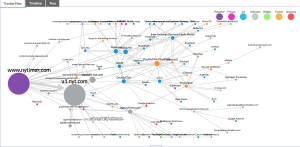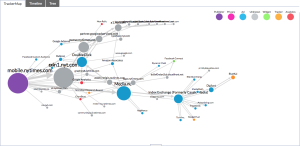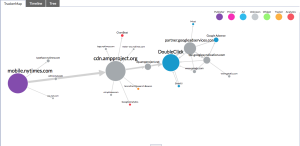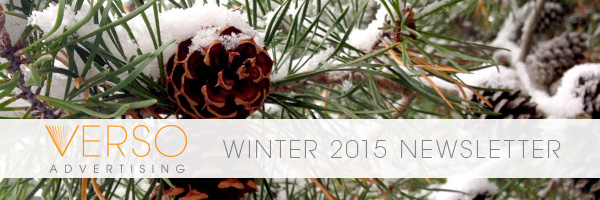Thanks to Digital Book World for hosting another engaging conference on the state of the art of book publishing in a digital world. Verso’s Tom Thompson enjoyed the smart, focused crowd on hand for his Master Class on Paid Digital Media and the packed audience for his panel on the Book-Buyer’s Journey with deeply insightful colleagues Peter Hildick-Smith of the Codex Group, Peter McCarthy of Logical Marketing, and Jack Perry from Highlights for Children.
There were many highlights from the three day conference—including very informative slide decks from Peter McCarthy and Rand Fishkin, chock-full of free tools for audience research and SEO best practices.
Here is a link to Peter McCarthy on free tools for finding a book’s audience.
And here is Rand Fishkin’s presentation on how to apply SEO startup tactics to book marketing.
We’ll post a link to Tom’s Master Class slides as soon as Digital Book World posts them.
#dbw #moz #SEO #audienceresearch
FACEBOOK UPS ITS LEAD GEN GAME
Facebook is adding products that make it a better lead generation tool for advertisers looking to bulk up their direct contact lists—including partnerships with email companies like Mail Chimp and Constant Contact. There’s a lot of change happening in the intersection between email and paid advertising these days, and strong indications that advertising to your email lists significantly boosts actions taken on emails. Any book publisher looking to bolster their direct email marketing capabilities should look at integrating it with advertising.
MOMS AND MOBILE ADVERTISING
eMarketer reports on a study that shows that not only do U.S. mothers spend more time online than the average population, but they are more open to mobile advertising than the average U.S. mobile user.
WHO LISTENS TO THE RADIO WHEN
A new study suggests that Millennials are the largest group of radio listeners, but the three generations each seem to prefer a different time of day:
“Interestingly, the top daypart for listening varies by generation, with Gen Xers most engaged during the morning drive (6AM-10AM), Boomers during the mid day (10AM-3PM) and Gen Xers during the evening drive (3PM-7PM).”
(Via @PeterMcCarthy)
PLAYBOY’S NATIVE AD OFFERING INCLUDES INSTAGRAM BUY
As part of Tullemmore D.E.W.’s native ad buy on Playboy, the publisher included a retargeting Instagram push for the whiskey. Related: Digiday has a short article on Macallan’s Instagram push. There’s something about whiskey that works on Instagram
FACEBOOK PULLS BACK ON DSP OFFERING
Facebook is holding off on creating its own Demand Side Platform (DSP), which would have put it in competition with companies like Turn, Rocketfuel, and Google Display for running programmatic campaigns. The reason is that it’s really hard to find and sell clean ad inventory (i.e. ad impressions seen by people not robots) and that they don’t want to release an inferior product. But I don’t think we’ve heard the end of them on this one. The good news is they’re working on bringing the native and video ad experience to play on DSPs where they currently are not:
“Brian Boland, Facebook’s vice president of ads product marketing, told Business Insider that native and video formats delivered “7X” better results than banner ads. The problem right now is that the majority of ads being bought through demand-side platforms on the desktop and mobile web are banner ads, so Facebook is refocusing Atlas’ plans around “building a product in our mission to help marketers deliver and measure true business value,” according to the blog post.”
Watch this space.
A more pointed quote picked up by Ad Age, Facebook’s head of ad tech declared himself “amazed by the volume of valueless inventory.”
#DSP #native #watchthisspace #facebook
FACEBOOK ADDS PATH-TO-CONVERSION TO ATLAS
Joining Google’s DoubleClick ad server, Facebook’s Atlas ad server now can measure whether ads on desktop or mobile devices drove a digital sale. Given Facebook’s user attribution warehouse of data — now extending across the web with FB log in — this should be a powerful tool. Facebook’s VP of advertising, Brian Boland says:
“It provides insight into how real people—not cookies—see ads across multiple devices.”
#facebook #atlas #pathtoconversion
NEW YORK MAGAZINE GOES NATIVE
New York Magazine is upping its commitment to the native advertising—announcing that 33% of 2015 revenue came from native formats—with a key new hire in its branded content department.
NEW UNITS IN FB ADVERTISING
Click Z details the latest units in advertising on Facebook.
BETTER ROBOT LEARNING THROUGH FICTION
Stanford researchers are using Wattpad stories to teach AI how to predict human response. This counts as a point for both arts and science disciplines.
DARK TRAFFIC ON THE RISE
Websites rely on knowing where their audience is coming from so they can understand their audience. A recent article in the Guardian points out that it’s getting harder to do that, with about 15% of the Guardian traffic coming from unknown sources. Whether it’s email mentions, stray Reddit threads, or “Spotlight” searches on their iPhones (the biggest unknown according to researchers), the effort to understand the origins of this “Dark Traffic” is underway.
“‘It’s not just a referral agency problem; it’s a user problem deep down,’ points out strategy director David Carr at DigitasLBi. ‘The journey is broken for users who need to jump around in apps and on browser, because ad tech is getting in the way. That strips out the attribution. What could be a connected journey becomes disjointed. If we solve it for the user, we might solve the attribution.’ But that’s easier said than done.”
USING THE SECOND SCREEN
Broadcast isn’t dead. Americans still watch 5 hours of television a day. But that doesn’t mean TV advertisers should ignore the digital space. According to Google, two thirds of Americans watching TV have used their mobile screens to learn more about something they saw in an ad.
IMPROVING AD VIEWABILITY ON MOBILE
In an article about how Google’s AMP project aims to improve the mobile advertising experience, Frederic Filloux points to an Adweek article about the problem with ad load times in mobile:
“44 percent of mobile ads served are deemed viewable compared with 52 percent of desktop promos, primarily because smartphone-wielding consumers often scroll faster than websites can load ads. Once someone is on a site, 76 percent of mobile readers choose to scroll down a website versus 63 percent of desktop users who do the same.
That spells bad news for publishers who don’t load ads at a lightning-fast speed. Per Moat, the average mobile user starts scrolling on a website 13 seconds after content begins loading. Desktop readers, on the other hand, wait 24 seconds before clicking down a page, which gives ads more time to load.”
NEWSLETTERS ARE THE NEW BLOGS
On Twitter, @swissmiss, Tina Roth Eisenberg, says “Newsletters are the new blogs.” This may be true, but newsletters are a tool that have worked exceedingly well for advertisers since email began.






